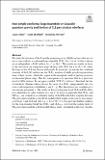Non-simple conformal loop ensembles on Liouville quantum gravity and the law of CLE percolation interfaces
Author(s)
Miller, Jason; Sheffield, Scott; Werner, Wendelin
Download440_2021_Article_1070.pdf (2.244Mb)
Publisher with Creative Commons License
Publisher with Creative Commons License
Creative Commons Attribution
Terms of use
Metadata
Show full item recordAbstract
Abstract
We study the structure of the Liouville quantum gravity (LQG) surfaces that are cut out as one explores a conformal loop-ensemble
$$\hbox {CLE}_{\kappa '}$$
CLE
κ
′
for
$$\kappa '$$
κ
′
in (4, 8) that is drawn on an independent
$$\gamma $$
γ
-LQG surface for
$$\gamma ^2=16/\kappa '$$
γ
2
=
16
/
κ
′
. The results are similar in flavor to the ones from our companion paper dealing with
$$\hbox {CLE}_{\kappa }$$
CLE
κ
for
$$\kappa $$
κ
in (8/3, 4), where the loops of the CLE are disjoint and simple. In particular, we encode the combined structure of the LQG surface and the
$$\hbox {CLE}_{\kappa '}$$
CLE
κ
′
in terms of stable growth-fragmentation trees or their variants, which also appear in the asymptotic study of peeling processes on decorated planar maps. This has consequences for questions that do a priori not involve LQG surfaces: In our paper entitled “CLE Percolations” described the law of interfaces obtained when coloring the loops of a
$$\hbox {CLE}_{\kappa '}$$
CLE
κ
′
independently into two colors with respective probabilities p and
$$1-p$$
1
-
p
. This description was complete up to one missing parameter
$$\rho $$
ρ
. The results of the present paper about CLE on LQG allow us to determine its value in terms of p and
$$\kappa '$$
κ
′
. It shows in particular that
$$\hbox {CLE}_{\kappa '}$$
CLE
κ
′
and
$$\hbox {CLE}_{16/\kappa '}$$
CLE
16
/
κ
′
are related via a continuum analog of the Edwards-Sokal coupling between
$$\hbox {FK}_q$$
FK
q
percolation and the q-state Potts model (which makes sense even for non-integer q between 1 and 4) if and only if
$$q=4\cos ^2(4\pi / \kappa ')$$
q
=
4
cos
2
(
4
π
/
κ
′
)
. This provides further evidence for the long-standing belief that
$$\hbox {CLE}_{\kappa '}$$
CLE
κ
′
and
$$\hbox {CLE}_{16/\kappa '}$$
CLE
16
/
κ
′
represent the scaling limits of
$$\hbox {FK}_q$$
FK
q
percolation and the q-Potts model when q and
$$\kappa '$$
κ
′
are related in this way. Another consequence of the formula for
$$\rho (p,\kappa ')$$
ρ
(
p
,
κ
′
)
is the value of half-plane arm exponents for such divide-and-color models (a.k.a. fuzzy Potts models) that turn out to take a somewhat different form than the usual critical exponents for two-dimensional models.
Date issued
2021-06-26Department
Massachusetts Institute of Technology. Department of MathematicsPublisher
Springer Berlin Heidelberg